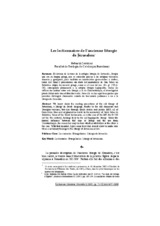Les lectionnaires de l’ancienne liturgie de Jérusalem

Ver/
Autor
Janeras, Sebastià
Editor
Universidad de Córdoba, Servicio de PublicacionesFecha
2005Materia
LectionariesEvangeliaries
Liturgy of Jerusalem
Leccionarios
Liturgia de Jerusalén
Evangeliarios
METS:
Mostrar el registro METSPREMIS:
Mostrar el registro PREMISMetadatos
Mostrar el registro completo del ítemResumen
We know about the reading procedures of the old liturgy of Jerusalem, a liturgy in Greek language, thanks to the old Armenian and Georgian versions, but also through Greek-Arabic and Arabic MSS, all of them from Sinai and originated no doubt in the monastery of Saint Sabas in Palestina. Some of the Greek lectionaries, as is the case of the MS Sin.Gr 210 (of the 9th century), belongs fully to the old hagiopolite liturgy. Given the mutual influence between this type of liturgy and the one from Constantinople, the researcher may hesitate whether attribution or the other is the case. With that in mind, I give some keys that should allow us make sure when a lectionary belongs to the liturgy of Jerusalem or not. El sistema de lecturas de la antigua liturgia de Jerusalén, liturgia que era en lengua griega, nos es conocido gracias a las antiguas versiones armenia y georgiana, pero también en manuscritos greco-árabes y árabes, todos del Sinaí y procedentes sin duda del monasterio de San Sabas en Palestina. Algún leccionario griego, como es el caso del ms. Sin. gr. 210 (s. IX), corresponde plenamente a la antigua liturgia hagiopolita. Dadas las influencias mutuas entre esta liturgia y la de Constantinopla, el investigador puede dudar entre una atribución u otra. Para ello se dan aquí unas pautas que permiten distinguir claramente cuándo un leccionario pertenece o no a la liturgia de Jerusalén.
